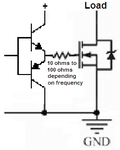francis29
Member level 5
I want to use a mosfet for switching power supply.
I want to know how much current gate will source/sink? I am getting the PWM from a microcontroller. Can i directly connect the mosfet gate to the microcontroller or i have to use specific driver?
Is there any formula to calculate gate current?
I want to know how much current gate will source/sink? I am getting the PWM from a microcontroller. Can i directly connect the mosfet gate to the microcontroller or i have to use specific driver?
Is there any formula to calculate gate current?

